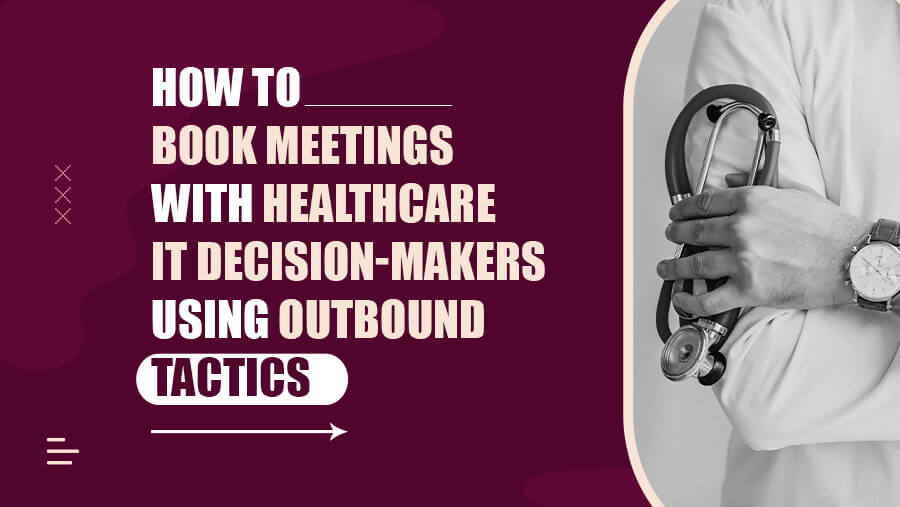
How to Book Meetings with Healthcare IT Decision-Makers Using Outbound Tactics
You already know how critical appointment setting is to drive sales and boost your bottom line. But have you ever taken a closer look at the actual costs associated with this process?
You’ve got an excellent healthcare IT solution. Maybe it improves EHR efficiency, enhances data security, or streamlines operations. But there’s one big problem:
How do you actually get in front of the people who need it most?
Healthcare IT decision-makers—CIOs, IT directors, and tech leads—are tough to reach. They manage complex systems, tight budgets, and endless compliance challenges, so booking a meeting with them can feel like a Herculean task.
But it’s not impossible. In this guide, we’ll show you how to use intelligent outbound tactics—emails, calls, LinkedIn, and more—to cut through the noise and get these critical decision-makers to sit down with you.
Ready? Let’s dive in.
Step 1: Understand Who Healthcare IT Decision-Makers Are.
Before you start any outreach, you need to fully understand who these healthcare IT leaders are and what they care about.
Typically, you’ll be targeting:
- Chief Information Officers (CIOs)
- Chief Technology Officers (CTOs)
- IT Directors
These professionals are responsible for the technology that keeps hospitals, clinics, and healthcare systems running smoothly. They make decisions about everything from EHR systems to cybersecurity and often manage large teams and even bigger budgets.
Understanding their daily challenges will give you valuable insights to create outreach that truly resonates.
Challenges Faced by HealthCare IT Decision Makers
Healthcare IT leaders are dealing with a lot. Here’s what typically fills their to-do lists:

The key to booking meetings with these decision-makers is to focus on how your solution addresses these exact challenges.
Step 2: Build a Targeted Prospect List
You need to be strategic about who you contact. Start by creating a well-researched prospect list tailored to your solution. Here’s how…
Find the Right Contacts
- Use LinkedIn: Use LinkedIn’s advanced search features to find CIOs, CTOs, and IT directors at healthcare organizations.
- Browse Healthcare Directories: Platforms like Definitive Healthcare or Healthgrades can give you insights into hospitals and clinics.
- Attend Industry Events: Keep an eye on speakers and attendees at healthcare IT conferences.
Research Your Prospects
Once you’ve got your list, dig deeper into each prospect. Learn about:
- The Organization’s Size and Structure: Are they an extensive hospital network or a smaller clinic? This affects their tech needs.
- Recent initiatives: Have they invested in new IT infrastructure recently? Are they expanding into telemedicine?
- Pain points: What challenges are they likely facing? Are they focused on EHR optimization, security, or patient data management?
This research helps you craft personalized outreach, crucial for booking meetings with high-level decision-makers.
Step 3: Craft Cold Emails That Get Responses
Now that you know who you’re talking to, it’s time to reach out. Cold emails are a crucial part of outbound marketing, but let’s be honest—healthcare IT leaders get tons of emails every day. Yours needs to stand out.
As such, use the following elements:
Subject Lines That Grab Attention
Your subject line is the first thing they’ll see, so it needs to hit home fast. A great subject line should:
- Be short and specific.
- Speak to their pain points.
Examples:
- "How We Helped [Hospital] Cut IT Costs by 20%"
- "Reduce Your EHR Downtime—Here’s How"
Body Content That Solves Problems
The body of your email should focus on them, not you. Keep it brief and laser-focused on how you can help solve their most pressing problems.
Here’s a template to consider:

Follow Up Without Being Annoying
Most decision-makers won’t respond to the first email. That’s okay. A well-planned follow-up sequence is essential:
- Send a second email within 3-5 days.
- Refer to the first email briefly and offer more value (like a case study or industry insight).
Persistence is key, but keep it respectful and professional.
Step 4: Make Cold Calling Work for You
Cold-calling healthcare IT leaders can be intimidating, but when done right, it’s one of the most direct ways to get on their radar.
Start Strong with a Value Proposition
The first 30 seconds of your call are everything. Open with something relevant and valuable:
- "Hi [Name], I know your team is working on optimizing your EHR system at [hospital]. We’ve helped similar organizations reduce downtime and improve system efficiency—would you have 10 minutes to discuss how we could support you?"
This shows them immediately that you’ve done your homework and understand their challenges.
Handle Objections Gracefully
Expect objections—they’re part of the game. Common ones include:
- "We don’t have the budget."
- "We already have a solution in place."
- "We’re too busy right now."
Overcome these by emphasizing the long-term benefits your solution offers:
- "I understand that budget’s a concern, but we’ve helped similar organizations reduce costs by streamlining their IT operations. Could I show you how we might be able to do the same for you?"
End with a Strong CTA
When you’ve established rapport, ask for the meeting:
- "Would you be open to a 15-minute call next week to explore this further?"
Step 5: Leverage LinkedIn for Multi-Channel Outreach
Incorporating LinkedIn into your outreach strategy can increase your chances of booking a meeting. Here’s how:
Connect First, Pitch Later
Start by sending a connection request with a brief note, such as:
- "Hi [Name], I noticed that you’re focused on improving healthcare IT systems at [hospital]. I’d love to connect and share some insights from our work with similar organizations."
Once connected, engage with their posts or send a thoughtful follow-up message with value (like a case study or relevant article).
Use Content to Warm Up Cold Prospects
Sharing educational content is a great way to warm up prospects before asking for a meeting. Send them a whitepaper, case study, or webinar that addresses a key challenge they’re facing.
Step 6: Overcome Common Barriers in Healthcare IT Outreach
Let’s discover practical strategies to navigate healthcare IT challenges, from gatekeepers to compliance.
Gatekeepers
Healthcare organizations often have gatekeepers who screen calls and emails. To get through, be respectful but direct about the value of your solution and how it aligns with the decision-maker’s goals.
Compliance Concerns
Healthcare is a highly regulated industry, so decision-makers may have concerns about compliance (e.g., HIPAA). Proactively address this in your outreach:
- "Our solution is fully HIPAA-compliant and designed to meet the strictest healthcare data standards."
Step 7: Track, Measure, and Improve Your Efforts
Finally, successful outbound marketing is all about continuous improvement. Track key metrics like:
- Email open rates
- Call response rates
- Meeting conversion rates
Use A/B testing to refine your approach—experiment with different subject lines, email content, and call scripts to see what works best.
The Bottomline
Booking meetings with healthcare IT decision-makers isn’t easy, but it's absolutely doable with the right outbound tactics. The key is understanding their unique challenges, personalizing your outreach, and staying persistent (without being pushy).
Ready to Book More Meetings with Healthcare IT Decision-Makers?
Revnew can help you reach healthcare IT leaders using proven outbound strategies. Don’t let your solution go unnoticed—partner with us to craft personalized, high-impact outreach that addresses their unique challenges and gets you in the room with the decision-makers who matter.
Let’s start a conversation. Schedule a consultation today to discuss how we can tailor our approach to fit your goals.

.jpg?width=60&name=deepti%20(2).jpg)


